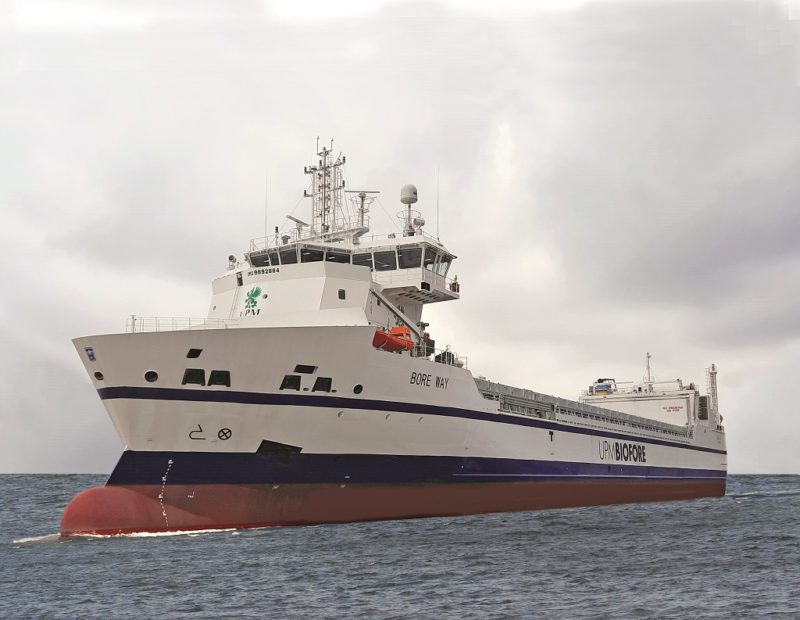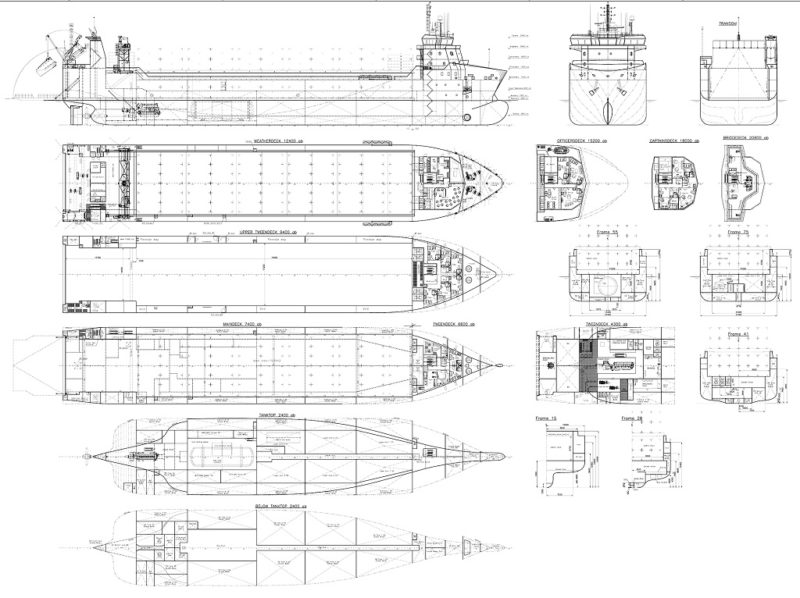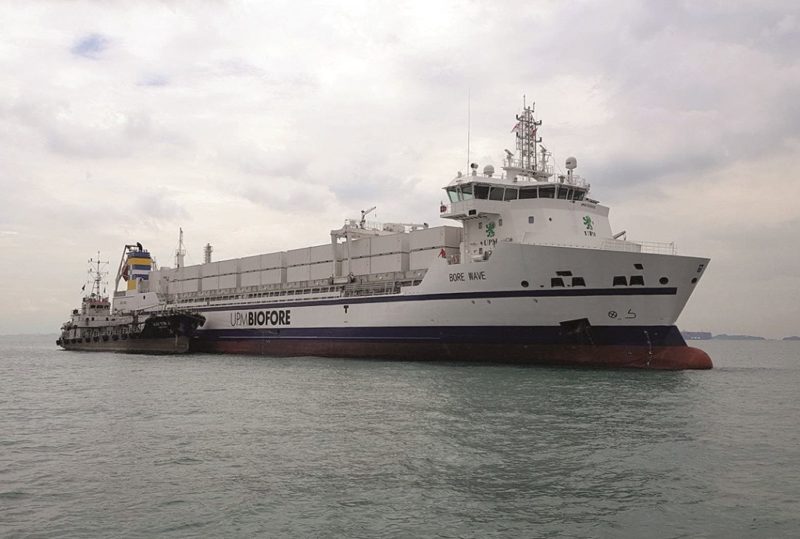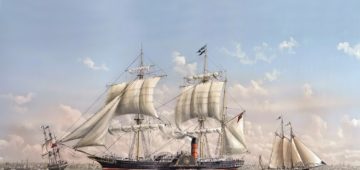The shipping company Bore has long traditions in shipping, and today’s business is focussed on flexible solutions to the cargo transportation requirements of its clients. The company began operations in 1897 as the Bore Steamship Company and its first ship was the S.S. Bore, built for year-round service between Turku and Stockholm. She was delivered in 1898. The evolution towards the company’s era of Ro-Ro cargo operations started when Bore entered the cargo service trade in 1924, from Finland to the North Sea region. In 1967, the company introduced the first Ro-Ro vessel in Finland that was equipped with a stern ramp.
In 1926 a Finland-South America service was opened, which operated for 30 years. In 1958 the Finnish Steamship Company, Rederieaktiebolaget Svea, and Bore founded Silja Line for a passenger service between Finland and Sweden. This service continues today under the ownership of the Tallink Grupp. In 1980 Bore left the passenger shipping industry and focussed on cargo shipping with the 17,884grt Bore King and Bore Queen being delivered. These ships went on to serve P&O North Sea Ferries 1991-2013 as the Norking and Norqueen. In 1987 Bore merged into the Rettig Group and, 4 years later, Rettig and Finnlines agreed a transfer of the Bore Line operations to the Finnlines Group. In 1999 the 20,296gt Ro-Ros Norsky and Norstream were delivered from Aker Finnyards, Rauma, Finland and still serve P&O Ferries’ diminished network today.
In 2007 Bore, Engship and BHC merged into a new shipowner, namely Rettig Group Ltd. Bore Ship owning Company. In 2011 Bore became Bore Ltd. and invested in the 25,586gt RoFlex vessels Bore Sea and Bore Song, delivered from Flensburg, Germany and the subject of a Newbuild of the Month at the time. In 2015 a decision, which was to be short-lived as it happens, was made to only operate tonnage under the Finnish flag. The following year Bore was acquired by the Dutch Spliethoff Group and in 2017 the Bore Sea and Bore Song switched to the Dutch flag. Most recently, Bore signed a new-building contract with Wuhu Shipyard Co. Ltd. in China during 2019 for a trio of new LNG-powered Ro-Lo vessels to be delivered during 2022, namely the 9,133gt Bore Way, Bore Wave and Bore Wind. The remainder of the Bore fleet consists of the 10,572gt/1997-built Bore Bay (converted back to Ro-Ro from a vehicle carrier), the 18,205gt/1999-built Estraden and the 10,488gt/1999-built Seagard. Including these Ro-Ros, the fleet totalled 10 ships at the time of writing.
The Bore Way/Wave/Wind form the subject of this feature. The vessels were products of the Wuhu Shipyard Co. Ltd., formerly known as Fujiheng Machinery Plant, established in 1900. The shipyard is the largest shipbuilding enterprise in Anhui Province and has passed the certification of ship industry standard conditions, ISO9001 quality system certification, occupational health and safety management system, energy management system and environmental management system certification. The yard’s products include platform supply ships, 18,000gt heavy crane ships, 24,000gt heavy crane ships, platform guard ships, 28,000gt chemical tankers, 800 CEU capacity Ro-Ro ships, 82,000gt bulk carriers and 64,000gt bulk carriers.
Built for Purpose
As a company committed to providing solutions for its Clients, Bore ordered the trio of Ro-Lo ships for charter by the UPM-Kymmene Corporation after UPM approached Bore in early 2019 with a request to build three 7,000 dwt Ro-Lo ships to operate in north-western European waters under long-term charter agreements. Key requirements for these vessels included ice class, LNG propulsion, high fuel efficiency, and strong structural reinforcements to manage heavy cargo transport. The UPM-Kymmene Corporation was established in autumn 1995 when Kymmene Corporation and Repola Ltd. (and subsidiary United Paper Mills Ltd) announced their merger. The new company, UPM-Kymmene, officially started its operations on 1st May 1996. The company history goes back to the origins of the Finnish forest industry with the group’s first mechanical pulp mill, paper mills and sawmills opening for business in the early 1870s. Pulp production began in the 1880s and paper converting in the 1920s with plywood production following in the 1930s. The company’s family tree has roots in Valkeakoski and Kuusankoski in Finland with the predecessors Aktiebolag Walkiakoski and Kymmene Ab being established in 1871 and 1872, respectively. Many significant Finnish forest industry companies such as Kymi, United Paper Mills, Kaukas, Kajaani, Schauman, Rosenlew, Raf. Haarla and Rauma-Repola have merged into the current UPM Group over the years.
The present day UPM Group consists of six business areas: UPM Fibres, UPM Energy, UPM Raflatac, UPM Specialty Papers, UPM Communication Papers and UPM Plywood. Built for both wheeled and containerised cargo, the UPM Biofore branded ships operate rotations including Kotka- Rauma-Rostock plus a round trip to Ferrol/Santander every third week. The keel laying date for all three ships is stated as 15th December 2020 following the contract date of 13th August 2019. The Swedish/Finnish ice class 1A ships were built as Yard Nos. W1911/W1912/W1913 and were launched as the Bore Way/Wave/Wind on 16th July 2021/8th November 2021 and 19th January 2022. Delivery followed on 27th April 2022/9th November 2022 and 21st December 2022.
The new class of Ro-Lo ship is 121.89m long overall with a beam of 21.00m, a draught of 6.75m and a freeboard of 2,528mm. The gross tonnage is 9,133 with a deadweight of 6,775 and a net tonnage of 2,740. The layout of what is referred to as the MPV 330 design by some sources is a simple one to maximise cargo capacity. The 14m wide and 120 tonnes capacity stern ramp provides access for lorries and heavy cargo handling equipment. With the superstructure in the far forward position, the cargo hold is also fully accessible from above by gantry cranes, and the lift-off hatch covers are strong enough to carry containers. Whilst these vessels will carry a wide variety of forestry products, whether in break bulk form, on trailers or in containers, the transport of paper reels is a primary role and involves the most stringent requirements. The 9-deck ship design was calculated by using paper reels as the reference cargo with exceptional structural strength and rigidity a priority to avoid elastic deformation in rough sea conditions or while loading and unloading heavy rolls of paper. As this cargo is highly sensitive to temperature and air moisture changes there is a need to protect it from quality-damaging environmental influences. So, the hatch covers and the stern ramp had to form tight seals when closed, with the cargo hold being climate-controlled. Dehumidification of the cargo hold requires an extensive system of air ducts that needed to be integrated into the walls of the hold without compromising the structure of the ship or the required damage stability criteria. The main cargo hold is 75.60m long with a breadth of 17.20m. This area is 1,581m2 in size and has a cargo capacity of 8,700m3. If used for containers, 132 TEU can be carried in the main hold or 435 lanemetres of wheeled cargo, loaded via the stern ramp. Aft of the main deck is a smaller Ro-Ro space that can be separated from the cargo hold by a stowable bulkhead. This garage is 17.70m long and 14.50m wide. The area is 281 m2 and has a 30 lanemetre (1,750m3) capacity for vehicles. This generally represents a maximum of 18x13m trailers. The vehicle lane widths are laid out for 2.90m minimum, the enclosed deck clear height is 6.70m and the deckload limits are 42 tonnes (MAFI) and 72 tonnes (Buggy). The 1,581m2 weather deck area mirrors that of the main cargo deck, features pontoon type hatch covers and can accommodate 132 TEU.

The crew of 12 have their accommodation in the 6-tier deckhouse situated in the bow. The lower level is on the Tweendeck, containing the gym, smoke room, sauna, changing room and two twin guest cabins. The Upper Tweendeck level has 6 crew cabins and above at Weatherdeck level is the mess/day room, provision stores and galley. Next level up is the Officer’s Deck, featuring two Officer’s cabins, the Chief Cook’s cabin, and the ship’s office. The Captain’s Deck is one level beneath the bridge and provides sleeping/living accommodation for the captain, 1st Officer and Chief Engineer.
The machinery spaces are situated aft with the main engine being a 4-stroke and 4,000kW Wärtsilä 8L 34 DF unit, running on LNG. This drives a SCV95 Wärtsilä Norway AS gearbox with power take-off (VFD) for electrical power generation. The 250m3 capacity type-C LNG tank is located forward of the engine room. The tank capacity is sufficient for one round trip between Finland and western Europe.
The ship can also carry 295m3 of marine gas oil. Onboard power is provided by a pair of AB Volvo Penta D13 B-E MG generators plus an AB Volvo Penta D7C /A -BTA/ -TA/ -T emergency generator.
Propulsion is provided via a Wärtsilä WCP 4G1290 propeller and a Wärtsilä WTT11 FP bow thruster is also fitted. The ship’s service speed is 13.5 knots with a maximum speed of 15 knots.
Roll Out
The first ship, the Bore Way (above), was launched on 16th July 2021, delivered on 27th April 2022 and she made her way home to Europe carrying cargo. The ship was christened at a ceremony on 1st July 2022 at the Port of Rauma..
The Bore Wave was launched on 8th Nov 2021, delivered on 9th November 2022 and loaded containers at Taicang, Port of Suzhou, China and then Ningbo, China before heading home via the Suez Canal and the Mediterranean Sea. The ship reached Bremen, Germany and Rotterdam, The Netherlands, in early January 2023 to unload her cargo of containers before continuing to Rauma, Finland, to enter her charter for UPM alongside the Bore Way. The first crew change was done in Singapore and her first LNG bunkering was done in Rauma, Finland. The Bore Wave was named at Rauma on 3rd February 2023 by her godmother, Leena Hölsä. The ship then continued her work with a sailing to Rostock.
Finally, the Bore Wind (above), which was launched on 19th January 2022 and delivered on 21st December 2022, completed the trio. She followed the same route home to Europe as her sisters with cargo onboard and discharged in both Rotterdam and Antwerp before sailing to Amsterdam for her naming ceremony on 21st February 2023. The christening was undertaken by the ship’s godmother, Marjo Van Den Berg. From Amsterdam the vessel sailed to Finland and joined the UPM trade along with her sisters.









Comments
Sorry, comments are closed for this item